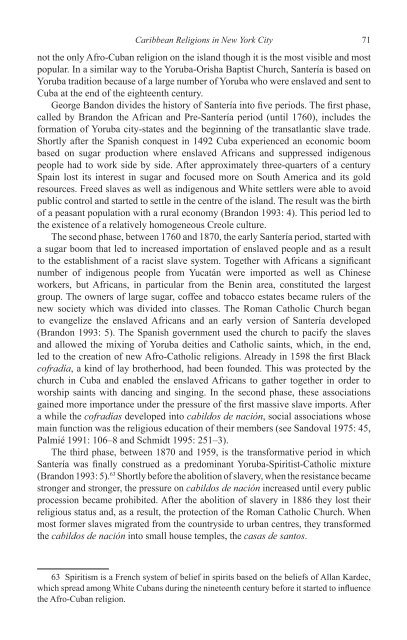Create successful ePaper yourself
Turn your PDF publications into a flip-book with our unique Google optimized e-Paper software.
<strong>Caribbean</strong> <strong>Religions</strong> <strong>in</strong> <strong>New</strong> <strong>York</strong> <strong>City</strong> 71<br />
not <strong>the</strong> only Afro-Cuban religion on <strong>the</strong> island though it is <strong>the</strong> most visible and most<br />
popular. In a similar way to <strong>the</strong> Yoruba-Orisha Baptist Church, Santería is based on<br />
Yoruba tradition because <strong>of</strong> a large number <strong>of</strong> Yoruba who were enslaved and sent to<br />
Cuba at <strong>the</strong> end <strong>of</strong> <strong>the</strong> eighteenth century.<br />
George Bandon divides <strong>the</strong> history <strong>of</strong> Santería <strong>in</strong>to five periods. The first phase,<br />
called by Brandon <strong>the</strong> African and Pre-Santería period (until 1760), <strong>in</strong>cludes <strong>the</strong><br />
formation <strong>of</strong> Yoruba city-states and <strong>the</strong> beg<strong>in</strong>n<strong>in</strong>g <strong>of</strong> <strong>the</strong> transatlantic slave trade.<br />
Shortly after <strong>the</strong> Spanish conquest <strong>in</strong> 1492 Cuba experienced an economic boom<br />
based on sugar production where enslaved Africans and suppressed <strong>in</strong>digenous<br />
people had to work side by side. After approximately three-quarters <strong>of</strong> a century<br />
Spa<strong>in</strong> lost its <strong>in</strong>terest <strong>in</strong> sugar and focused more on South America and its gold<br />
resources. Freed slaves as well as <strong>in</strong>digenous and White settlers were able to avoid<br />
public control and started to settle <strong>in</strong> <strong>the</strong> centre <strong>of</strong> <strong>the</strong> island. The result was <strong>the</strong> birth<br />
<strong>of</strong> a peasant population with a rural economy (Brandon 1993: 4). This period led to<br />
<strong>the</strong> existence <strong>of</strong> a relatively homogeneous Creole culture.<br />
The second phase, between 1760 and 1870, <strong>the</strong> early Santería period, started with<br />
a sugar boom that led to <strong>in</strong>creased importation <strong>of</strong> enslaved people and as a result<br />
to <strong>the</strong> establishment <strong>of</strong> a racist slave system. Toge<strong>the</strong>r with Africans a significant<br />
number <strong>of</strong> <strong>in</strong>digenous people from Yucatán were imported as well as Ch<strong>in</strong>ese<br />
workers, but Africans, <strong>in</strong> particular from <strong>the</strong> Ben<strong>in</strong> area, constituted <strong>the</strong> largest<br />
group. The owners <strong>of</strong> large sugar, c<strong>of</strong>fee and tobacco estates became rulers <strong>of</strong> <strong>the</strong><br />
new society which was divided <strong>in</strong>to classes. The Roman Catholic Church began<br />
to evangelize <strong>the</strong> enslaved Africans and an early version <strong>of</strong> Santería developed<br />
(Brandon 1993: 5). The Spanish government used <strong>the</strong> church to pacify <strong>the</strong> slaves<br />
and allowed <strong>the</strong> mix<strong>in</strong>g <strong>of</strong> Yoruba deities and Catholic sa<strong>in</strong>ts, which, <strong>in</strong> <strong>the</strong> end,<br />
led to <strong>the</strong> creation <strong>of</strong> new Afro-Catholic religions. Already <strong>in</strong> 1598 <strong>the</strong> first Black<br />
c<strong>of</strong>radía, a k<strong>in</strong>d <strong>of</strong> lay bro<strong>the</strong>rhood, had been founded. This was protected by <strong>the</strong><br />
church <strong>in</strong> Cuba and enabled <strong>the</strong> enslaved Africans to ga<strong>the</strong>r toge<strong>the</strong>r <strong>in</strong> order to<br />
worship sa<strong>in</strong>ts with danc<strong>in</strong>g and s<strong>in</strong>g<strong>in</strong>g. In <strong>the</strong> second phase, <strong>the</strong>se associations<br />
ga<strong>in</strong>ed more importance under <strong>the</strong> pressure <strong>of</strong> <strong>the</strong> first massive slave imports. After<br />
a while <strong>the</strong> c<strong>of</strong>radías developed <strong>in</strong>to cabildos de nación, social associations whose<br />
ma<strong>in</strong> function was <strong>the</strong> religious education <strong>of</strong> <strong>the</strong>ir members (see Sandoval 1975: 45,<br />
Palmié 1991: 106–8 and Schmidt 1995: 251–3).<br />
The third phase, between 1870 and 1959, is <strong>the</strong> transformative period <strong>in</strong> which<br />
Santería was f<strong>in</strong>ally construed as a predom<strong>in</strong>ant Yoruba-Spiritist-Catholic mixture<br />
(Brandon 1993: 5). 63 Shortly before <strong>the</strong> abolition <strong>of</strong> slavery, when <strong>the</strong> resistance became<br />
stronger and stronger, <strong>the</strong> pressure on cabildos de nación <strong>in</strong>creased until every public<br />
procession became prohibited. After <strong>the</strong> abolition <strong>of</strong> slavery <strong>in</strong> 1886 <strong>the</strong>y lost <strong>the</strong>ir<br />
religious status and, as a result, <strong>the</strong> protection <strong>of</strong> <strong>the</strong> Roman Catholic Church. When<br />
most former slaves migrated from <strong>the</strong> countryside to urban centres, <strong>the</strong>y transformed<br />
<strong>the</strong> cabildos de nación <strong>in</strong>to small house temples, <strong>the</strong> casas de santos.<br />
63 Spiritism is a French system <strong>of</strong> belief <strong>in</strong> spirits based on <strong>the</strong> beliefs <strong>of</strong> Allan Kardec,<br />
which spread among White Cubans dur<strong>in</strong>g <strong>the</strong> n<strong>in</strong>eteenth century before it started to <strong>in</strong>fluence<br />
<strong>the</strong> Afro-Cuban religion.


















